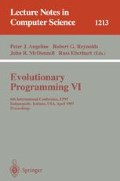Abstract
In genetic programming, crossover swaps randomly selected subtrees between parents. Recent work in genetic algorithms ([13]) demonstrates that when one of the parents selected for crossover is replaced with a randomly generated parent, the algorithm performs as well or better than crossover for some problems. [13] termed this form of macromutation headless chicken crossover. The following paper investigates two forms of headless chicken crossover for manipulating parse trees and shows that both types of macromutation perform as well or better than standard subtree crossover. It is argued that these experiments support the hypothesis that the building block hypothesis is not descriptive of the operation of subtree crossover.
Preview
Unable to display preview. Download preview PDF.
References
Angeline, P. J. (1994). Genetic Programming and Emergent Intelligence. In Advances in Genetic Programming, K. Kinnear (ed.), Cambridge, MA: MIT Press, pp. 75–96.
Angeline, P. J. (1996). Two Self-Adaptive Crossover Operations for Genetic Programming. In Advances in Genetic Programming: Volume II, P. Angeline and K. Kinnear (eds.), Cambridge MA: MIT Press, pp. 89–110.
Angeline, P. J. (1996). An Investigation into the Sensitivity of Genetic Programming to the Frequency of Leaf Selection During Subtree Crossover, In Genetic Programming 1996: Proceedings of the First Annual Conference, Koza, J., Goldberg, D., Fogel, D., and Riolo, R., (eds.), Cambridge MA: MIT Press, pp. 21–29.
Bäck, T. and Schwefel, H.-P. (1993). An Overview of Evolutionary Algorithms for Parameter Optimization, Evolutionary Computation, 1 (1), pp. 1–24.
Cramer, N. (1985) A Representation for the Adaptive Generation of Simple Sequential Programs. In Proceedings of an International Conference on Genetic Algorithms and their Applications, J. Grefensttete (ed.), Hillsdale, NJ: Lawrence Erlbaum.
Eshelman, L. J. and Shaffer, J. D. (1993) Crossover's Niche, In Proceedings of the Fifth International Conference on Genetic Algorithms, S. Forrest (ed.), San Mateo, CA: Morgan Kaufmann, pp. 9–14.
Fogel, D.B. (1995). Evolutionary Computation: Toward a New Philosophy of Machine Intelligence, Piscataway, NJ: IEEE Press.
Fogel, D. B. and Atmar, J. W. (1990) Comparing Genetic Operators with Gaussian Mutation in Simulated Evolutionary Processes Using Linear Systems, Biological Cybernetics, 63, pp 111–114.
Fogel, D. B. and Stayton, L. C. (1994). On the Effectiveness of Crossover in Simulated Evolutionary Optimization, BioSystems, 32, pp. 171–182.
Fogel, L.J., Owens, A.J. and Walsh, M.J. (1966). Artificial Intelligence through Simulated Evolution, New York: John Wiley.
Goldberg, D.E. (1989) Genetic Algorithms in Search, Optimization and Machine Learning, Reading, MA: Addison Wesley.
Holland, J.H. (1992). Adaptation in Natural and Artificial Systems, Ann Arbor, MI: University of Michigan Press.
Jones, T. (1995) Crossover, Macromutation, and Population-based Search, In Proceedings of the Sixth International Conference on Genetic Algorithms, L. Eshelman (ed.), San Francisco, CA: Morgan Kaufmann, pp 73–80.
Koza, J. R. (1992). Genetic Programming: On the programming of computers by means of natural selection. Cambridge, MA: MIT Press.
Koza, J. R. (1995). A Response to the ML-95 Paper Entitled “Hill Climbing Beats Genetic Search on a Boolean Circuit Synthesis Problem of Koza's,” Unpublished manuscript.
Oakley, E. H. N., (1994). Two scientific applications of genetic programming: stack filters and non-linear equation fitting to chaotic data. In Advances in Genetic Programming, K. Kinnear (ed.), Cambridge, MA: MIT Press, pp. 369–390.
O'Reilly and Oppacher (1996) The Troubling Aspects of a Building Block Hypothesis for Genetic Programming, In Foundations of Genetic Algorithms 3, L. D. Whitley and M. D. Vose (eds.), San Francisco, CA: Morgan Kaufmann, pp. 73–90.
Schwefel, H.-P. (1981). Numerical Optimization of Computer Models. Chichester, U.K: John Wiley.
Author information
Authors and Affiliations
Editor information
Rights and permissions
Copyright information
© 1997 Springer-Verlag Berlin Heidelberg
About this paper
Cite this paper
Angeline, P.J. (1997). Comparing subtree crossover with macromutation. In: Angeline, P.J., Reynolds, R.G., McDonnell, J.R., Eberhart, R. (eds) Evolutionary Programming VI. EP 1997. Lecture Notes in Computer Science, vol 1213. Springer, Berlin, Heidelberg. https://doi.org/10.1007/BFb0014804
Download citation
DOI: https://doi.org/10.1007/BFb0014804
Published:
Publisher Name: Springer, Berlin, Heidelberg
Print ISBN: 978-3-540-62788-3
Online ISBN: 978-3-540-68518-0
eBook Packages: Springer Book Archive

